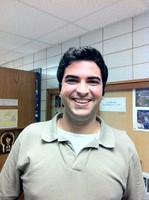
Taritree Wongjirad with his poster and Block award certificate


Taritree Wongjirad with his poster and Block award certificate
Summer student Ben Izatt created the Super-KAVE, a 3D immersive visualization in the DiVE of the Super-Kamiokande detector. You can fly around the detector, look at photomultiplier tube hits in time or charge mode, see the Cherenkov cone, and turn different particles on and off. Here’s a video, by Dave Zielinski, and here’s a supernova simulation.

The Super-KAVE event display

Ssohrab Borhanian

Remy Goldschmidt
High school student Remy Goldschmidt is visiting the Duke neutrino group from New York this summer, and Ssohrab Borhanian is a DAAD exchange undergraduate student from Germany. Welcome!
Zepeng, Chris and Kate all attended the International Neutrino Summer School in Blacksburg, VA: Zepeng as student, Chris as lecturer on atmospheric neutrinos, and Kate as organizer and tutor.

REU students get a tour of Super-K in the DiVE
Engineering undergrad Ben Izatt is working on a 3D version of the Super-K event display in the DiVE.
Postdoc Alex Himmel has won the 2012 URA thesis award for his Caltech thesis. Congratulations, Alex!

Chris, Kate, Tarek, Alex and Taritree (and Roger) all attended the Neutrino 2012 meeting in Kyoto.
New TUNL REU student Nikki Sanford will be working with the Duke Neutrino Group this summer. Welcome, Nikki!

Nikki Sanford

Josh and Chris after the defense
Josh has successfully defended his dissertation, and graduated from Duke University with a PhD in physics. His dissertation, on electron neutrino appearance at T2K, was defended in March, and the graduation ceremonies were held in May, 2012. He will be continuing his research into the nature of neutrinos with a postdoc for Indiana University, working on the Enriched Xenon Observatory experiment.
 The HALO detector is now in operation, since May 8, 2012.
The HALO detector is now in operation, since May 8, 2012.
The announcement from Clarence Virtue:
We are happy to share with you that, just in time for the grand opening of
SNOLAB, the Helium and Lead Observatory for Supernova Neutrinos (HALO) is
up and running. The concept of HALO dates back to 1996 when Cliff Hargrove
proposed the Lead Astronomical Neutrino Detector (LAND) as a long lifetime
supernova detector. In 2004 Charles Duba renamed the nascent detector to
HALO when we decided to use the 3He proportional counters from the SNO
experiment. The design and construction of HALO started in 2007.
The purpose of HALO is to observe the neutrinos from the next galactic
supernova. These particles stream out before the photons do, giving us an
opportunity to alert astronomers through the Supernova Early Warning
System (SNEWS) so that the light signal can be caught in real-time. Just
like we were able to look into the Sun with the SNO detector, HALO and
other supernova detectors, will give us a window into the mechanics of the
supernova explosion.
Although we still have much work to do to fully calibrate the detector, we
have all of the 128 proportional counters connected to 64 data acquisition
channels.
Supernova, we’re ready for you!